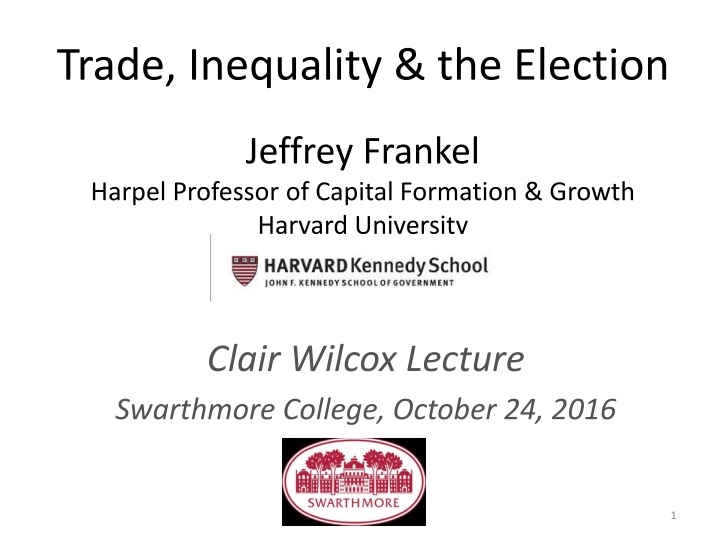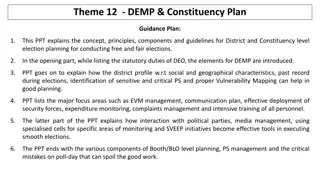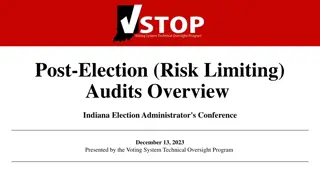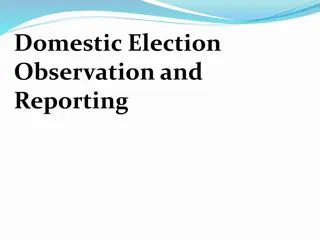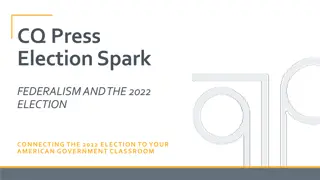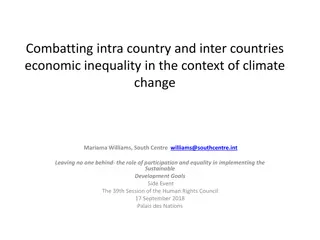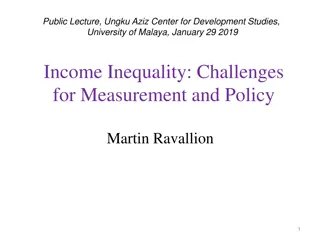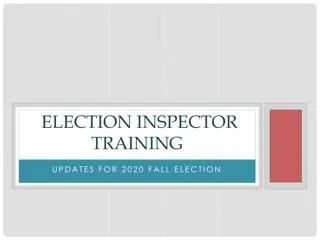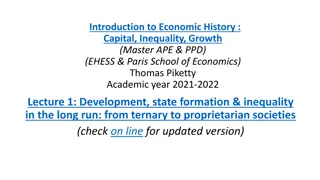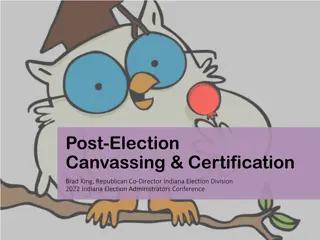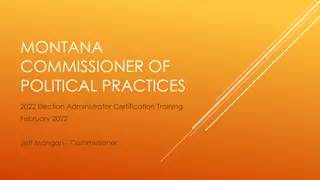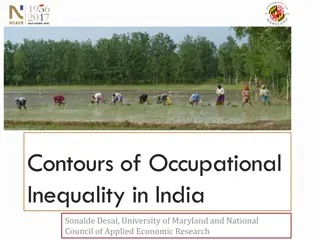Trade, Inequality & the Election: Impact and Perspective
The relationship between trade, inequality, and the recent election has sparked significant discussion. Trade, while beneficial for economic growth, raises concerns about its impact on income distribution and social unrest. The story of Trump's success shedding light on the hardships of those left behind by globalization. Insights on trade, inequality, and the election are explored alongside historical perspectives on notable figures such as Clair Wilcox.
Download Presentation

Please find below an Image/Link to download the presentation.
The content on the website is provided AS IS for your information and personal use only. It may not be sold, licensed, or shared on other websites without obtaining consent from the author.If you encounter any issues during the download, it is possible that the publisher has removed the file from their server.
You are allowed to download the files provided on this website for personal or commercial use, subject to the condition that they are used lawfully. All files are the property of their respective owners.
The content on the website is provided AS IS for your information and personal use only. It may not be sold, licensed, or shared on other websites without obtaining consent from the author.
E N D
Presentation Transcript
Trade, Inequality & the Election Jeffrey Frankel Harpel Professor of Capital Formation & Growth Harvard University Clair Wilcox Lecture Swarthmore College, October 24, 2016 1
Who was Clair Wilcox? Taught at Swarthmore from 1927 to 1968. In 1930, gave President Hoover a petition urging veto of the Smoot-Hawley tariff, signed by 1,028 U.S. economists. Led the effort after WWII to establish the International Trade Organization. General Agreement on Tariffs & Trade (GATT) signed in 1947; Havana Charter in 1948 to establish the ITO. But ITO ratification was blocked by Senate isolationists. Much as other noble US-led agreements have died in the Senate League of Nations (1919). SALT II (1979) Law of the Sea (1982) Kyoto Protocol on Climate Change (1997). The GATT served in place of the ITO, until the WTO in 1994. 2
Overview on Trade & Inequality Trade is good for economic growth, as measured by GDP. The doubts concern trade s effects on other things we care about in addition to income. Particularly inequality. The connection between trade and inequality has received intense interest in this strange presidential election year. Why did Trump s success catch elites so much by surprise? The story: we hadn t adequately realized how deep was the hardship and anger of those left behind by globalization Trade has led to inequality, and inequality has led to Trump. Analogous stories in Europe. I will talk about trade, then about inequality & its causes; then a bit about the election. 3
Trade & GDP Widely agreed: trade is good for economic growth. In theory: classical comparative advantage (Ricardo) and modern theories of trade based on imperfect competition (Krugman) & endogenous productivity (Melitz). Empirically: many econometric studies. E.g., one estimate: every .01 increase in a country s trade/GDP ratio raises income 3 % (over next 20 years). Most Americans seem to agree: Polls show surprisingly high support for trade. What about effects of trade on other objectives? Inequality? -> 4
We must note trade has helped global income distribution. The Economist, June 2013, The world has an astonishing chance to take a billion people out of extreme poverty by 2030 //www.economist.com/news/briefing/21578643-world-has-astonishing-chance-take-billion-people-out-extreme-poverty-2030-not 5
Global poverty has been cut more than 1/2 in the last 25 years In 1990, 43% of the population of developing countries lived in extreme poverty (then defined as $1 a day) = 1.9 billion people. By 2010 it was down to 21% = 1.2 billion. The Economist, June 2013, The world has an astonishing chance to take a billion people out of extreme poverty by 2030 //www.economist.com/news/briefing/21578643-world-has-astonishing-chance-take-billion-people-out-extreme-poverty-2030-not 6
Inequality & anti-globalization. Elections are domestic, of course. Typical explanation for the surprise Trump nomination: Globalization US inequality. Anger from those left behind who then support radical changes. We should have seen it coming, but were out of touch. To summarize my take: Inequality has unquestionably risen, esp. in US. Trade & immigration probably play roles, along with a long list of other factors. I don t see the inequality issue logically leading to Trump. There are some clear answers to the question: How can we address the wellbeing of workers who have been left behind? 7
Needless to say, trade creates both winners & losers. So does every change. E.g., putting up tariffs would create both winners and losers. If we economists require Pareto superiority before recommending one policy over another, then we can never make any recommendations: someone always loses. Economists can make win-win policy recommendations if we express the distributional consideration in terms of a desired measure of overall inequality. We can approve a policy that, while raising total income, also reduces the Gini coefficient, lowers the poverty rate, or raises median income. 8
Does trade worsen inequality? The Second Welfare Theorem of Economics suggests free trade increases the size of the pie by enough that the winners could compensate the losers, so that everyone comes out ahead, in theory. But, we need to consider, first: are the losers from trade concentrated in the lower segments of the income distribution? A simple encapsulation includes three effects -- (+) Consumption: the opportunity to import at lower prices and with greater variety works to raise real income for all. My guess is that this helps lower-income families. (-) Imports tend to hurt those in import-competing sectors. (+) Those losses are offset by the gains for exporting sectors. Export jobs pay an estimate 18% more. 9
What does trade theory say about income distribution? Ironically, the trade theory that dominated academic research during the 1950s-70s was Heckscher-Ohlin-Samuelson, which gives solidly respectable grounds for fearing trade would hurt American workers even in absolute terms. It divides the population into Unskilled workers vs. others (owners of capital or land, or skilled workers) The Stolper-Samuelson theorem specifically predicts that workers in a capital-abundant country will lose from trade (wages fall), even though total real national income goes up. The H-O-S theory never did fit the facts very well empirically, and does not include the advances in trade theory since 1980. Still 10
What about NAFTA? Didnt it devastate workers? No. Listening to claims that NAFTA hurt American workers, one would never guess that the half-decade after it went into effect featured the most job creation in the last 40 years. In 1996-2000 GDP growth averaged 4.3%, productivity growth = 2.5% Unemployment < 4% by end-2000. It s the one period since the 1970s when lower-income workers shared fully in the gains: real compensation/hour rose 2.2%, median family income rose strongly: from $26,401 in 1993 to $35,166 in 2000 [in real $2002], and the poverty rate declined steadily from 33.1% in 1993 to 22.5% in 2000. Needless to say, lots of factors underlay those achievements. 11
Recent research on job loss in import-competing sectors David Autor, David Dorn & Gordon Hanson (2013, 2016) have found evidence that a sizeable portion of lost US manufacturing jobs can indeed be associated with imports, especially from China. Employment & income in areas hit by such job losses can stay depressed for a much longer time than some had imagined. 12
The share of US income going to the top has indeed risen since 1980, and is now back to the 1920s. 13 Chad Stone et al, CBPP, Sept 30, 2016 www.cbpp.org/research/poverty-and-inequality/a-guide-to-statistics-on-historical-trends-in-income-inequality
Why has inequality risen in the US? 1. Trade probably does play a role, alongside other factors: 2. technological change raising demand for skilled workers, 3. outpacing education that raises the supply; 4. winner-take-all labor markets, 5. assortative mating, 6. reduced corporate competition & higher rents, 7. excessive executive compensation; 8. and Piketty s wealth accumulation. 14
2. Widening gap between skilled & unskilled workers, defined by college graduation. 15 Jason Furman, CEA, Oct. 17, 2016, Fig.10.
3. Trend in years of education slowed during 1981-2012. Mean Years of Schooling at Age 30, U.S. Native-Born, by Year of Birth, 1876-1982 Trend Trend 1906 1981 = 1876+30 to 1951+30. 1981 2012 = 1951+30 to 1982+30. 16 Jason Furman, CEA, Oct. 17, 2016, Fig.11.
4. Winner take all labor markets Taylor Swift earned $170 million last year, making her the world s highest paid celebrity (according to Forbes). 17
5. Assortative mating Crudely put: highly educated & highly paid male professionals used to marry their secretaries, but now are more likely to marry highly educated & (relatively) highly paid women; and the couple passes the advantages on to their children. 18
6. The share of US national income going to labor has declined since 2000 in part due to increased market power of firms, says Furman. 19 Jason Furman, CEA, Oct. 17, 2016, Fig.13.
7. Excessive compensation? Many top-1%-ers are executives and/or in finance. Composition of Top 1 Percent Income Share by Primary Occupation 20 Jason Furman, CEA, Oct. 17, 2016, Fig.4a.
8. Supporting Piketty: The share of wealth at the top has also been rising. 21 Chad Stone et al, CBPP, Sept 30, 2016 www.cbpp.org/research/poverty-and-inequality/a-guide-to-statistics-on-historical-trends-in-income-inequality
On the other hand, the big increase in inequality has been within labor (and within capital). 22 Jason Furman, CEA, Oct. 17, 2016, Fig.15.
What weights should we place on each of these 8 factors in explaining increased inequality? I don t know. Probably all or most of them merit some weight: Trade, technology, education, winner-take-all, assortative mating, rents, executive compensation, or Piketty s wealth accumulation. Surely one must diagnose the cause before deciding on the corresponding remedy? No, I don t think one has to. 23
The Second Fundamental Welfare Theorem. When individuals are free to engage in trade, the size of the economic pie increases enough that the winners could in theory compensate the losers, in which case everyone would be better off. Skeptics of globalization may understand this theorem and yet, reasonably, point out that the compensation in practice tends to remain hypothetical. They suggest that we should take the political failure to compensate losers as given, and so try to roll back globalization. But an alternative would be the reverse strategy: take globalization as given and instead work on trying to help those left behind. This is the sensible strategy. Why? 24
For one thing, it would be difficult to reverse globalization even if we wanted to. Even leaving aside the negative effects of trade wars on economic growth, and the geopolitical damage, nothing a president does would be likely to bring trade back down to the levels of 60 years ago, and still less likely to bring the number of manufacturing jobs back up anywhere near the levels of 60 years ago. 25
We are not going back to 1950, when manufacturing jobs were 32% of the national total vs. down to 10% by 2010 -- any more than we are going back to 1790 when farmers were 90% of national employment, vs. 2% today. Percent of employment in US manufacturing (1970-2012) 26
Some of those lost jobs were in autos & steel, where those northern workers who lacked a college education but were lucky enough to get a job in those two industries could earn a high income. Since 1960, the number of jobs in sectors like steel fell by ; while the number of jobs in health care increased 6-fold. International trade was one factor that helped put an end to those high-paying jobs (along with productivity growth and relocation from the north to the south) while improving the reliability, fuel efficiency and affordability of cars for all of us not just importing autos, but also making US autos competitive again. Regardless, it is hard to see how we could go back. 27
The most effective policies to help those left behind ( to compensate the losers ): The program to help specifically those losing their jobs due to trade is Trade Adjustment Assistance (which the Democrats try to expand). But why help only the small number of workers who have identifiably lost their jobs due to trade agreements? Wouldn t it be better to help those who have been left behind regardless if the cause is trade, technology, or something else? and to do it in ways that still reward work. 28
Sensible policies to help those left behind include: Wage insurance (as proposed by Obama in SoTU); More progressive income tax system (central to HRC s plan) including an expanded Earned Income Tax Credit, and more progressive payroll tax rates too; and universal health insurance (e.g., Obamacare & beyond). Universal pre-school ed. (again, favored by Obama & HRC); infrastructure investment spending; Financial regulation, such as Dodd-Frank and beyond (e.g., Hillary Clinton s proposal to impose a risk fee on large financial institutions). The other party tries to block these measures, arguing that government overreach impedes growth. In that respect, the choice in this election is the same as usual. 29
Appendices Appendix 1: A century of US trade liberalization Job losses in manufacturing Appendix 2: Opinion polls on trade Appendix 3: Trade and the environment Appendix 4: Improved global income distribution. Appendix 5: For each of 8 inequality diagnoses, one might think of a targeted policy response. 30
Appendix 1: US Import Tariff Rates have Declined to Historical Lows Data Source: US International Trade Commission 31 Struyven, 30 Sep 2016, US Economics Analyst: The Economics of Higher Tariffs
US Tariffs are Low Except On Agriculture & Apparel Source: World Trade Organization 32 Struyven, 30 Sep 2016, US Economics Analyst: The Economics of Higher Tariffs
The evolving employment mix Jobs in clothing and steel fell by half Textiles 1960 924 2002 433 Apparel 1960 1,233 2002 522 1 Metal 1960 1,185 2002 593 while the number of jobs in health care increased six-fold: Health 1960 2002 1,548 10,661 33
Some of the decline in US manufacturing jobs can indeed be associated with imports, especially from China. according to David Autor, David Dorn and Gordon Hanson, The China shock: Learning from labour market adjustment to large changes in trade , NBER WP 21906, 2016. And The China syndrome: Local labour market effects of import competition in the United States , American Economic Review, 2013. Economist, Feb 6th 2016, 34 Trade in the balance: Globalisation can make everyone better off. That does not mean it will
Polls tend to show Americans support trade A survey last month by the nonpartisan Pew Research Center found Americans by 50 to 42 % said trade agreements had been a good thing for the US. July Washington Post-ABC News poll. Asked if they wanted the next president to support trade agreements or oppose them, 75 % of respondents said they wanted a supporter Vs. 17 percent favored an opponent. A Gallup poll early this year found that 58 percent of Americans viewed trade as an economic opportunity, 34 percent as a threat. Similarly, in a July poll for NBC News, 55 % of registered voters agreed with a statement that trade was good because it opens up new markets and we cannot avoid the fact that it is a global economy, while 38 % agreed trade was bad because it has hurt manufacturing and other key industries. 36 Source: NY Times Sept. 21, 2016 Who Hates Free Trade Treaties? Surprisingly, Not Voters
Appendix 3: Trade can have either positive or negative effects on the environment. Example of negative effects: Race to the bottom in environmental regulation among national governments pursuing of cost-competitiveness. Example of positive effects: Trade in environmental goods & services. US ended 1980s tariffs & quotas on fuel-efficient Japanese autos, benefiting both consumer pocketbooks & air quality. Almost of EU trade-remedy barriers currently target imports of products used for renewable energy! (Kasteng, 2013; Wu, 2014) AD remedies currently block trade in solar power inputs: US has AD tariffs on imports of Chinese solar panels (2012, 2014, 2015). China has them against imports of polysilicon from US & EU (2012 & 2016); EU has penalties on imports of Chinese solar glass & panels (2013, 2015). They should be dropped, either by negotiation or unilaterally. 37
Which tend to dominate in practice, positive or negative effects of trade on the environment? Econometric estimates depend on environmental criterion. For SO2 Trade seems to be beneficial Environmental Kuznets Curve => at higher incomes, people want to clean the environment. For CO2 Even at high levels of income, trade continues to hurt. The freerider problem => popular desire for environmental quality cannot be enacted at the national level, absent an effective multilateral treaty la Paris Agreement. Frankel & Rose, Review of Ec. & Stats. (2004). 38
Appendix 4: Global inequality fell sharply 1970-2000. https://ourworldindata.org/global-economic-inequality Over the last 25 years, poverty has fallen especially rapidly in such countries as China, Indonesia & India 39
For each of the 8 inequality diagnoses, one might think of a targeted policy response: 1. Trade Trade Adjustment Assistance or, better yet, wage insurance. 2. Technology and3. education Make college more accessible to lower-income students. 4. Winner-take-all labor markets. An rise in income taxes & payroll taxes for the upper 0.1%. 5. Assortative mating Education again, especially universal pre-school. 40
For each of the 8 inequality diagnoses, a targeted policy response continued: 6. Reduced corporate competition and increased monopoly rents More aggressive anti-trust action. 7. Executive compensation, especially in finance Reforms such as say on pay, separating the function of CEO & Chairman of the Board, claw-back provisions, and so on; Continued financial reform, begun under Dodd-Frank e.g., Hillary s risk-tax on large financial institutions. Higher tax rates on the upper 0.1% and, very specifically, eliminating the carried-interest deduction. 8. Piketty s wealth accumulation: -- Inheritance tax, at least on estates above $5 million. 41
